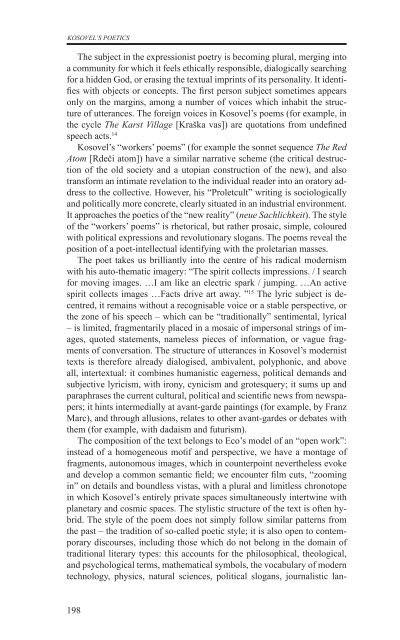razprave (pdf) - Društvo za primerjalno književnost - ZRC SAZU
razprave (pdf) - Društvo za primerjalno književnost - ZRC SAZU
razprave (pdf) - Društvo za primerjalno književnost - ZRC SAZU
- No tags were found...
You also want an ePaper? Increase the reach of your titles
YUMPU automatically turns print PDFs into web optimized ePapers that Google loves.
KOSOVEL’s poeticsThe subject in the expressionist poetry is becoming plural, merging intoa community for which it feels ethically responsible, dialogically searchingfor a hidden God, or erasing the textual imprints of its personality. It identifieswith objects or concepts. The first person subject sometimes appearsonly on the margins, among a number of voices which inhabit the structureof utterances. The foreign voices in Kosovel’s poems (for example, inthe cycle The Karst Village [Kraška vas]) are quotations from undefinedspeech acts. 14Kosovel’s “workers’ poems” (for example the sonnet sequence The RedAtom [Rdeči atom]) have a similar narrative scheme (the critical destructionof the old society and a utopian construction of the new), and alsotransform an intimate revelation to the individual reader into an oratory addressto the collective. However, his “Proletcult” writing is sociologicallyand politically more concrete, clearly situated in an industrial environment.It approaches the poetics of the “new reality” (neue Sachlichkeit). The styleof the “workers’ poems” is rhetorical, but rather prosaic, simple, colouredwith political expressions and revolutionary slogans. The poems reveal theposition of a poet-intellectual identifying with the proletarian masses.The poet takes us brilliantly into the centre of his radical modernismwith his auto-thematic imagery: “The spirit collects impressions. / I searchfor moving images. …I am like an electric spark / jumping. …An activespirit collects images …Facts drive art away. ” 15 The lyric subject is decentred,it remains without a recognisable voice or a stable perspective, orthe zone of his speech – which can be “traditionally” sentimental, lyrical– is limited, fragmentarily placed in a mosaic of impersonal strings of images,quoted statements, nameless pieces of information, or vague fragmentsof conversation. The structure of utterances in Kosovel’s modernisttexts is therefore already dialogised, ambivalent, polyphonic, and aboveall, intertextual: it combines humanistic eagerness, political demands andsubjective lyricism, with irony, cynicism and grotesquery; it sums up andparaphrases the current cultural, political and scientific news from newspapers;it hints intermedially at avant-garde paintings (for example, by FranzMarc), and through allusions, relates to other avant-gardes or debates withthem (for example, with dadaism and futurism).The composition of the text belongs to Eco’s model of an “open work”:instead of a homogeneous motif and perspective, we have a montage offragments, autonomous images, which in counterpoint nevertheless evokeand develop a common semantic field; we encounter film cuts, “zoomingin” on details and boundless vistas, with a plural and limitless chronotopein which Kosovel’s entirely private spaces simultaneously intertwine withplanetary and cosmic spaces. The stylistic structure of the text is often hybrid.The style of the poem does not simply follow similar patterns fromthe past – the tradition of so-called poetic style; it is also open to contemporarydiscourses, including those which do not belong in the domain oftraditional literary types: this accounts for the philosophical, theological,and psychological terms, mathematical symbols, the vocabulary of moderntechnology, physics, natural sciences, political slogans, journalistic lan-198
















